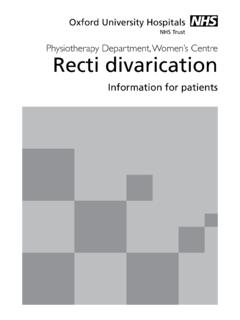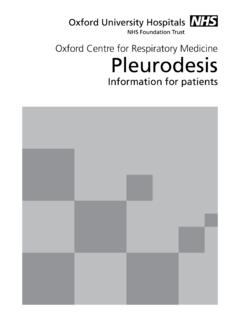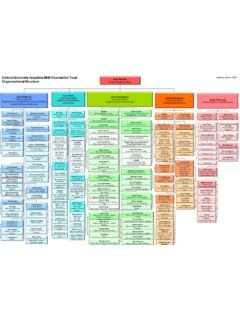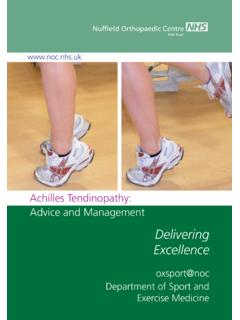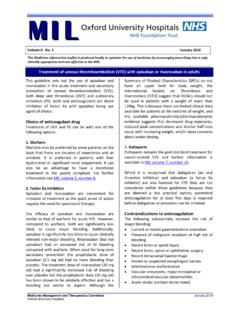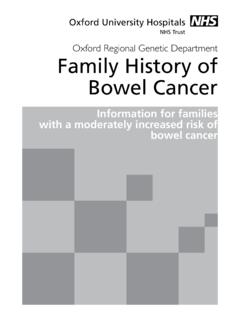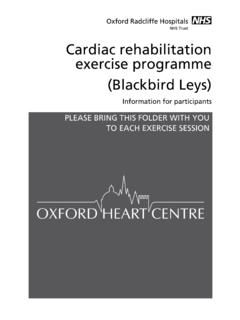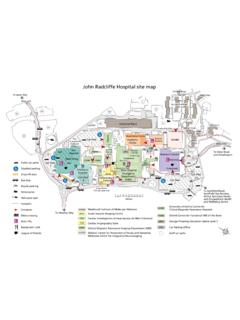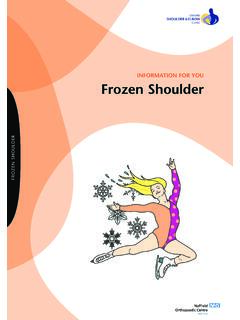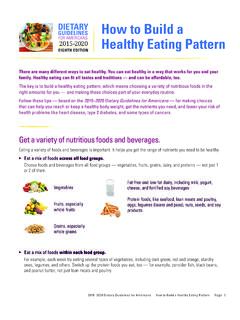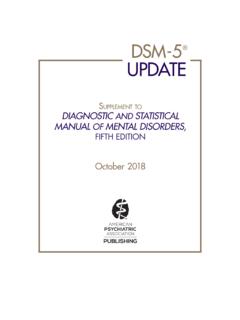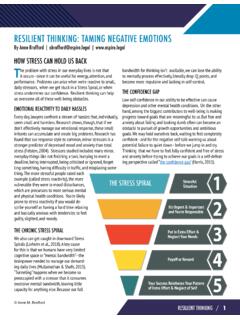Transcription of OUTPATIENT POST-OPERATIVE PHYSIOTHERAPY GUIDELINES
1 1 Modified August 2019 Clare Scott-Dempster OUTPATIENT POST-OPERATIVE PHYSIOTHERAPY GUIDELINES Rotator Cuff Repair Please remember, individual patients will progress differently and their post operative protocol will be dependent on both the size of the tear and how secure the repair is. This primarily affects the length of time the arm is kept in the sling (up to 6 weeks) Cuff tears are named by convention small (less than 1cm), medium (1-3cm), large (3-5cms) and massive (over 5cms). Supraspinatus is nearly always involved and as the tear size increases infraspinatus and biceps tendon can be affected. If there is a massive tear subscapularis /teres minor as well.
2 Rarely there can be an isolated subscapularis tear when post operative instructions may differ. The quality of the tissue is usually determined first via MRI. Tissues showing increased fatty infiltration or tendon retraction may not be operated on. Acute tears are more likely to be operated on than degenerative tears. Acute tears (particularly involving any trauma) are a priority referral as the window of 6 weeks avoids significant shortening of the tendon and better outcomes. Steroid injections are not routinely given for pain with people with RC tears, or after repairs as it raises the chances of revision surgery due to apoptosis at the injection site, and decreased microvascularisation, cell proliferation, and pull-out strength of suture anchors.
3 Go steady with rehabilitation time scales if they have had pre operative injections. This surgery is done arthroscopically if possible, however if open access to the cuff is needed a mini-open approach is used by detaching a small portion of the Deltoid from the acromion and then splitting the muscle vertically. If this is the case then caution with active flexion up to 6 weeks. Exercise and activity progression should be based on clinical judgement taking the operation details and post operative instructions into account. Pain control and regaining antigravity movement are key milestones in recovery. This protocol is for use with patients who have had a rotator cuff repair +/- sub- acromial decompression which is normally done as a precursor to the repair, to open the sub-acromial space.
4 If a patient has had any additional procedures, POST-OPERATIVE notes will need to be adhered to. General GUIDELINES for rehabilitation Routine (secure) repairs of small/medium/ large cuff tears at the NOC are immobilised in the sling for 3 weeks. Massive (often only partial repair achieved) or less secure large repairs may be immobilised for up to 6 weeks. Check post-op instructions and operation details. A high proportion of rotator cuff repairs are not healed at one year (MRI scans) (UKUFF monograph), some studies link this with early mobilisation (Littlewood et al) though 2 Modified August 2019 Clare Scott-Dempster patients generally do well even if this is the case.
5 However better outcome scores have been found for those whose repair has healed (UKUFF monograph HTA). Advice on Return to Activity Driving: When adequate ROM and safe to control the car. Able to react in the event of an emergency able to perform an emergency stop. This will be dependent on the time is the sling but may not be possible for approximately 6 weeks. Work: Those in desk based roles should be able to return to work when comfortable and able to perform duties (with agreed modifications from the employer, if necessary). This may be at 4-6 weeks. Those in more manual work should be guided by the ability of the patient to perform the functional activities of their job.
6 Swimming: Movement in water can be very helpful. However swimming is likely to be modified doggy paddle, modified breast stroke and then progressing to free style (if possible). This will be dependent on range of movement and pain levels but swimming may be delayed until 8-12 weeks. Non Contact sports ( racket sports, rock climbing, football, martial arts): This will be dependent on range of motion, control and strength in relation to the tasks wishing to be undertaken. Improvements in strength can continue for up to 2 years. Strength training can start from 12 weeks. Sports with the potential for contact ( football) or falling (skiing) may not be recommended for 4-6 months.
7 Week 0 3 Aims Suggested Treatment Pain well controlled Protect Rotator cuff repair Wounds healthy Encourage patient compliance Complete Appropriate Outcome Measure Maintain lower limb strength Maintain Axilla hygiene Teach carer to complete passive exercises if the patient is not able to do them alone OR is tending to do active movement. Regular ice as needed Elbow, Neck & Wrist ROM exercises Scapula setting in sitting Teach removal of sling/ brace as well as education on resting positions. Ensure appropriate OPA made for approx. 3-4/52 time Passive flexion supine (assisted with unaffected arm) Passive external rotation supine to 0.
8 Use stick between hands & towel under humerus for support. Can take beyond 0 , if range before tension on repair is greater than 0 and recommended in operation notes. Pendular exercises 3 Modified August 2019 Clare Scott-Dempster Restrictions Key Milestones to Achieve Immobilisation of shoulder for the first 3/52 or up to 6/52 for large/ massive tears Do NOT complete passive external rotation if the subscapularis has been repaired rare but should be recorded in op notes. Ensure patient aware of how to protect surgical repair. Pain controlled 3/10 on the VAS Exercises once a day if good mobility, twice a day otherwise, three times a day if tendency to be stiff.
9 *Emphasis passive nature of the movement reinforce this with the patient* Week 3-6 Aims Suggested Treatment Wean out of the sling as control increases Aim to regain active movement Regain maximal passive movement Minimal pain Improve scar mobility Return to light work at 6/52 Postural awareness Correct movement pattern Continue with passive ROM exercises of the GH joint. Take to early tight sensation but no forcing or sudden stretching Active assisted shoulder elevation (in scaption) start with short lever arm (elbow flexed). Use of pulleys, auto-assisted, table slides. Scapula stability work (sitting, prone lying as comfort allows) Isometric cuff work in neutral position (pain free and scapula stable) Maintain lower body strength Elbow, Neck and Wrist ROM Functional tasks at waist height eating , drinking and self care Restrictions Key Milestones to Achieve Do not target supraspinatus in the isometric strength work (abduction) Repair strength is likely to be 19-30% of normal at 6 weeks NO lifting or weights to be used Consider avoiding wall slide/ wall walk only introducing when patient can actively elevate to 130 without pain (ref)
10 Adequate scapula control Pain control Aim for 90 flexion and < 30 external rotation at 6/52 unless post-op restrictions Patients who have not met milestones should not be progressed Pain no more than 3/10 before moving on 4 Modified August 2019 Clare Scott-Dempster Week 6 12 Aims Suggested Treatment Minimal Pain Increase active ROM Increase cuff activation Postural control Optimal movement patterning Core stability work Progress active assisted movements extension, hand behind back, abduction Proprioception exercises we i ght bearing Progress cuff activity isometric (from 6/52) through range to progressive loading (9/52) Consider pulley & cane exercises, external rotation, internal rotation, rows and forward reaching.
